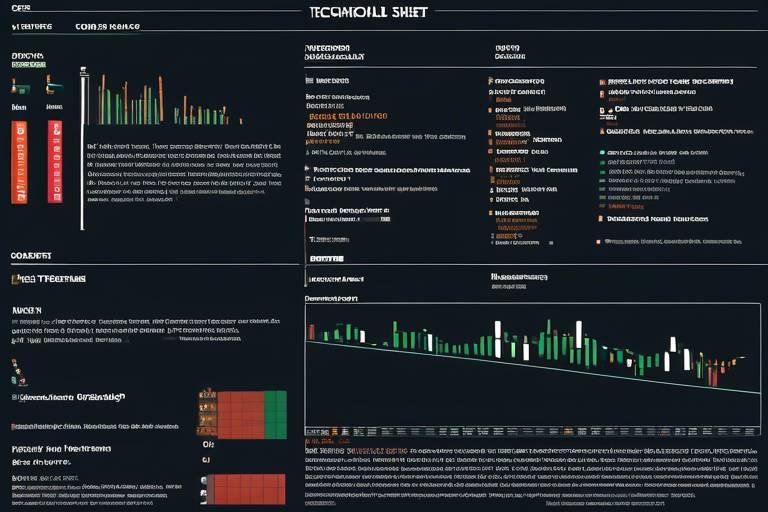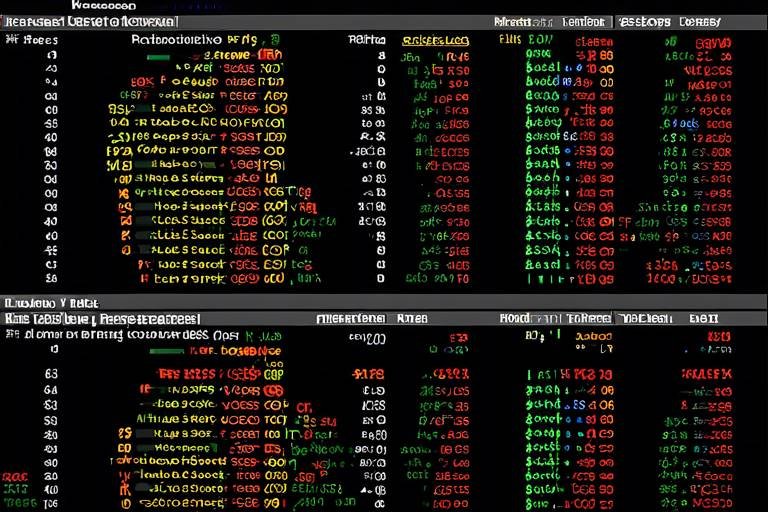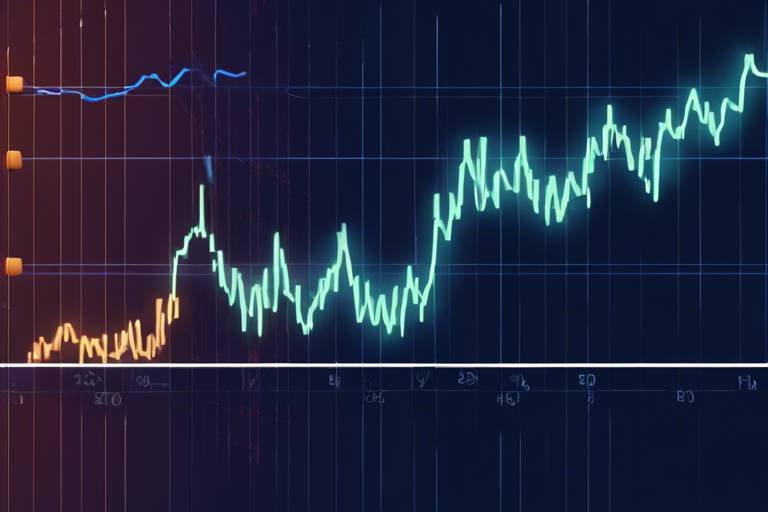How to Identify Overbought and Oversold Conditions in Crypto
In the ever-evolving world of cryptocurrency, understanding market dynamics is essential for traders aiming to make informed decisions. One of the most critical concepts to grasp is the idea of overbought and oversold conditions. These terms refer to the market's state where prices have moved too far in one direction, often leading to a correction. But how do you identify these conditions? In this article, we will explore the tools and indicators that can help you navigate these waters effectively.
Market sentiment is the collective attitude of traders towards a particular asset or market. It can be influenced by various factors, including news events, economic data, and social media trends. When traders feel optimistic, they tend to buy, driving prices up and potentially creating an overbought condition. Conversely, when fear prevails, selling pressure can lead to an oversold state. Recognizing these psychological triggers is crucial for identifying potential entry and exit points in your trading strategy.
To effectively identify overbought and oversold conditions, traders often rely on technical indicators. These tools provide valuable insights into market trends and price movements. Here are some popular indicators that can help:
- Relative Strength Index (RSI)
- Stochastic Oscillator
- Bollinger Bands
The Relative Strength Index, or RSI, is a momentum oscillator that measures the speed and change of price movements. It ranges from 0 to 100 and is typically used to identify overbought and oversold levels. An RSI value above 70 generally indicates that an asset may be overbought, while a value below 30 suggests it may be oversold. This can serve as a powerful signal for traders looking to capitalize on potential reversals.
Understanding the significance of RSI values is essential for effective trading. If the RSI reaches above 70, it may be time to consider taking profits or even shorting the asset. On the other hand, an RSI below 30 could signal a buying opportunity, as the asset may be undervalued. However, it’s crucial to remember that these signals should not be used in isolation; they work best when combined with other indicators and analysis methods.
Combining the RSI with other technical indicators can enhance your trading strategy. For instance, using the RSI alongside moving averages can provide a clearer picture of market trends. If the RSI indicates overbought conditions while a moving average crossover occurs, it could reinforce the signal to sell. This multi-faceted approach allows traders to make more informed decisions.
The Stochastic Oscillator is another popular tool for identifying overbought and oversold conditions. This indicator compares a particular closing price to a range of prices over a specific period. Typically, readings above 80 indicate overbought conditions, while readings below 20 suggest oversold conditions. By monitoring the Stochastic Oscillator, traders can spot potential trend reversals and adjust their positions accordingly.
Bollinger Bands are a volatility indicator that can signal overbought or oversold conditions. They consist of a middle band (the moving average) and two outer bands that represent standard deviations from that average. When prices touch or exceed the upper band, it may indicate an overbought condition, while prices hitting the lower band suggest an oversold state. Utilizing Bollinger Bands in your trading strategy can provide a visual representation of market volatility and potential price movements.
To effectively use Bollinger Bands, traders need to configure them according to their trading style. The standard settings typically include a 20-period moving average and two standard deviations. However, depending on market conditions, you might want to adjust these settings. For instance, in a highly volatile market, widening the bands can provide a more accurate depiction of price fluctuations.
Band breakouts can indicate potential trend reversals or continuations. If the price breaks above the upper band, it could signal that the asset is overbought and may soon reverse. Conversely, a price drop below the lower band might indicate an oversold condition, suggesting a buying opportunity. Understanding how to interpret these breakouts is essential for capitalizing on market movements.
Q: What does it mean when a cryptocurrency is overbought?
A: An overbought condition suggests that the asset has been purchased excessively, leading to inflated prices. This often precedes a price correction.
Q: How can I use the RSI effectively?
A: The RSI can be used to identify potential reversal points by looking for values above 70 (overbought) or below 30 (oversold). Combine it with other indicators for better accuracy.
Q: Are Bollinger Bands reliable indicators?
A: While Bollinger Bands provide valuable insights into volatility and price levels, they should be used in conjunction with other analysis methods for optimal results.

Understanding Market Sentiment
Market sentiment is like the heartbeat of the cryptocurrency world; it dictates the rhythm of price movements and can often lead traders to make decisions that are more emotional than rational. Just think about it: have you ever felt the rush of excitement when a coin skyrockets, or the sinking feeling when it plummets? That emotional rollercoaster is driven by trader psychology, which is influenced by various factors, including news events, social media discussions, and even the fear of missing out (FOMO).
Understanding market sentiment is essential for identifying overbought and oversold conditions. When traders are overly optimistic, they tend to push prices up beyond sustainable levels, creating an overbought condition. Conversely, when pessimism reigns, prices can drop significantly, leading to oversold conditions. Recognizing these extremes can help you make smarter trading decisions, rather than getting swept away by the tide of emotions.
To gauge market sentiment, you can look at various indicators and tools. For instance, social media sentiment analysis can provide insights into how traders feel about a particular cryptocurrency. A surge in positive tweets or posts can indicate bullish sentiment, while a spike in negative comments might suggest bearish sentiment. Additionally, you can utilize tools like the Fear and Greed Index, which quantifies market sentiment on a scale from fear to greed, giving you a clearer picture of the current market mood.
Moreover, the psychology behind trading is often cyclical. When prices rise, more traders jump in, hoping to ride the wave, which can further inflate prices. This phenomenon can lead to bubbles, where the asset's price becomes detached from its intrinsic value. On the flip side, during a downturn, panic can set in, leading to mass sell-offs and driving prices down even further. Understanding these cycles helps traders anticipate potential reversals and adjust their strategies accordingly.
In summary, market sentiment is a multifaceted concept that plays a pivotal role in identifying overbought and oversold conditions in the crypto market. By paying attention to trader psychology and leveraging various sentiment analysis tools, you can enhance your trading strategy and make more informed decisions. After all, in the fast-paced world of cryptocurrency, being aware of the emotional currents can be just as important as analyzing the numbers.

Key Indicators for Analysis
When it comes to navigating the wild waters of cryptocurrency trading, understanding key indicators is essential. These indicators act like your trusty compass, guiding you through the often turbulent market conditions. Among the plethora of tools available, a few stand out as particularly effective in identifying overbought and oversold conditions. Let's dive into some of these popular indicators and see how they can enhance your trading strategy.
One of the most widely recognized indicators is the Relative Strength Index (RSI). This momentum oscillator measures the speed and change of price movements, giving traders a clear picture of whether an asset is overbought or oversold. The RSI ranges from 0 to 100, typically using the 70 and 30 levels as critical thresholds. When the RSI is above 70, it indicates that the asset may be overbought, suggesting a potential price correction. Conversely, an RSI below 30 indicates oversold conditions, hinting that the price might bounce back. But remember, while RSI is a powerful tool, it’s not infallible. It’s best used in conjunction with other indicators to confirm your trading decisions.
Another valuable tool in your trading toolkit is the Stochastic Oscillator. This indicator compares a particular closing price to a range of prices over a specific period, helping traders identify momentum shifts. The Stochastic Oscillator also operates on a scale of 0 to 100, with values above 80 indicating an overbought condition and values below 20 suggesting oversold conditions. The beauty of the Stochastic Oscillator lies in its ability to signal potential reversals before they happen, giving you a crucial edge in your trading strategy.
To illustrate the differences and similarities between these indicators, here's a quick comparison table:
| Indicator | Range | Overbought Level | Oversold Level |
|---|---|---|---|
| Relative Strength Index (RSI) | 0 - 100 | Above 70 | Below 30 |
| Stochastic Oscillator | 0 - 100 | Above 80 | Below 20 |
Lastly, we can't overlook the significance of Bollinger Bands. This volatility indicator consists of a middle band (a simple moving average) and two outer bands that are standard deviations away from the middle band. When the price approaches the upper band, it can signal that the asset is overbought, while a price near the lower band may indicate oversold conditions. Bollinger Bands are particularly useful in trending markets, as they help traders gauge the volatility and potential price reversals.
In summary, utilizing these key indicators can significantly enhance your ability to identify overbought and oversold conditions in the cryptocurrency markets. By combining the insights gained from the RSI, Stochastic Oscillator, and Bollinger Bands, you can develop a more robust trading strategy that not only helps you make informed decisions but also maximizes your potential for profit. Remember, the key is to maintain a holistic view and not rely solely on one indicator. It’s all about piecing together the puzzle!
- What is the best indicator for spotting overbought conditions?
The Relative Strength Index (RSI) is one of the most popular indicators for identifying overbought conditions, typically using a threshold of 70. - How can I combine indicators for better analysis?
Using multiple indicators, such as the RSI and Stochastic Oscillator together, can provide a clearer picture of market conditions and help confirm trading signals. - Are Bollinger Bands effective in all market conditions?
Bollinger Bands are particularly useful in trending markets but may produce false signals in sideways markets. It's essential to consider the overall market context.

Relative Strength Index (RSI)
The is a powerful tool in the arsenal of any cryptocurrency trader. Developed by J. Welles Wilder, it serves as a momentum oscillator that helps traders gauge the speed and change of price movements. But what does that really mean? In simple terms, the RSI helps you determine whether a cryptocurrency is overbought or oversold, which can be crucial for making informed trading decisions. Imagine you're at a party, and everyone is dancing wildly; that’s the market in a bullish phase. But when the music slows down, and people start to sit down, it’s a sign that the party might be coming to an end—similar to how the RSI indicates potential reversals in price trends.
Typically, the RSI ranges from 0 to 100, with values above 70 indicating that a cryptocurrency may be overbought, while values below 30 suggest it might be oversold. But it’s not just about these numbers; understanding the context is key. For instance, if the RSI hits 75, it doesn’t automatically mean you should sell. Instead, consider the market conditions, news, and other indicators. It’s like checking the weather before going out; just because it’s sunny now doesn’t mean it won’t rain later!
To put it into perspective, let’s take a look at a simple table that summarizes RSI values and their implications:
| RSI Value | Market Condition | Trading Implication |
|---|---|---|
| Above 70 | Overbought | Consider selling or taking profits |
| 30 to 70 | Neutral | Hold or wait for clearer signals |
| Below 30 | Oversold | Consider buying or entering positions |
Now, let’s dive deeper into how to effectively interpret RSI values. When the RSI crosses above 70, it signals that the asset might be overbought, which could lead to a price correction. Conversely, when it dips below 30, it suggests that the asset may be oversold, presenting a potential buying opportunity. But here’s where it gets interesting—an RSI value can also indicate the strength of a trend. For example, if the RSI is consistently above 50 during an upward trend, it reinforces the idea that the bullish momentum is strong. Think of it as a cheering crowd at a sports event; the louder they cheer, the more likely the team is to win!
Another critical aspect of using RSI effectively is to combine it with other indicators. Why? Because no single indicator is foolproof. By using the RSI alongside tools like moving averages or the Stochastic Oscillator, you can create a more robust trading strategy. This combination can help you confirm signals and reduce the likelihood of false positives. It’s like having a GPS and a map; while one is great, together they provide a clearer direction.
In summary, the RSI is not just a number; it’s a reflection of market sentiment and momentum. By understanding how to interpret its values and using it in conjunction with other indicators, you can enhance your trading strategy and navigate the often tumultuous waters of the cryptocurrency market with greater confidence.
- What is a good RSI level to buy? Generally, an RSI below 30 suggests that an asset is oversold and might be a good buying opportunity.
- Can RSI be used for all cryptocurrencies? Yes, RSI can be applied to any asset, including stocks, forex, and cryptocurrencies.
- Is RSI reliable for predicting market movements? While RSI is a valuable tool, it’s essential to use it in conjunction with other indicators for better accuracy.

Interpreting RSI Values
The Relative Strength Index (RSI) is a powerful tool in the hands of traders, but its true potential is unlocked through proper interpretation of its values. Typically, the RSI ranges from 0 to 100, and understanding what these numbers signify can be the difference between making a profit and facing a loss. When the RSI crosses above the 70 threshold, it often indicates that a cryptocurrency is overbought. This means that the asset has experienced a rapid price increase and may be due for a correction. Conversely, if the RSI dips below 30, it suggests that the cryptocurrency is oversold, indicating that it may have been undervalued and could be poised for a rebound.
To put it simply, think of the RSI as a temperature gauge for the market. A reading above 70 is like a fever—something is not quite right, and a cool-down is likely. On the flip side, a reading below 30 is akin to hypothermia, suggesting that the market might be ready to warm up again. However, just like with any temperature reading, it’s essential to look for additional signals before making trading decisions. The RSI should not be used in isolation; it’s best to combine it with other indicators to confirm your trading strategy.
Moreover, it’s crucial to recognize that extreme RSI values do not always lead to immediate reversals. For instance, a cryptocurrency can remain overbought or oversold for extended periods, particularly in a strong trending market. Therefore, patience and a comprehensive analysis of market conditions are vital. Traders should also consider the overall trend when interpreting RSI values. If the trend is upward, an overbought condition might not signal a sell just yet, while in a downtrend, an oversold condition could indicate a temporary pause before further declines.
Let’s summarize the key points regarding RSI interpretation:
- RSI above 70: Indicates overbought conditions, potential for price correction.
- RSI below 30: Indicates oversold conditions, potential for price rebound.
- Use in conjunction: Combine RSI with other indicators for a well-rounded view.
- Consider the trend: Analyze the overall market trend before making decisions based on RSI.
By keeping these interpretations in mind, traders can better navigate the tumultuous waters of the cryptocurrency market. The RSI is not just a number; it’s a reflection of market psychology and sentiment. Understanding it can lead to more informed trading decisions and, ultimately, greater success in the crypto arena.

Using RSI in Conjunction with Other Indicators
When it comes to trading in the volatile world of cryptocurrency, relying solely on the Relative Strength Index (RSI) can sometimes lead to misleading conclusions. While the RSI is a powerful tool for identifying overbought and oversold conditions, its effectiveness can be significantly enhanced when used alongside other technical indicators. Think of it like cooking a gourmet meal; you wouldn't just use salt and expect a Michelin-star dish. Instead, you blend various ingredients to create a balanced flavor profile. The same concept applies to trading strategies.
One effective combination is using the RSI alongside the Moving Average Convergence Divergence (MACD). The MACD helps traders identify the direction and momentum of a trend. By observing both the RSI and MACD, traders can confirm signals. For instance, if the RSI indicates an overbought condition while the MACD shows a bearish crossover, it could signal a potential price drop. This dual confirmation can bolster your confidence in making trading decisions.
Another useful pairing is the RSI with Bollinger Bands. Bollinger Bands provide insight into market volatility and potential price reversals. When the price touches the upper band while the RSI is above 70, it may suggest that the asset is overbought. Conversely, if the price hits the lower band while the RSI is below 30, it could indicate an oversold condition. This interplay between indicators can help you pinpoint entry and exit points more effectively.
Additionally, incorporating Volume Indicators can further refine your analysis. Volume often precedes price movement, and when combined with the RSI, it can provide a clearer picture of market strength. For example, if the RSI indicates an overbought condition but volume is decreasing, it might suggest that the price rally is losing momentum, prompting traders to act cautiously.
In summary, using the RSI in conjunction with other indicators creates a more robust trading strategy. By combining insights from the RSI, MACD, Bollinger Bands, and volume indicators, traders can develop a multi-faceted approach to analyzing market conditions. This holistic view not only enhances decision-making but also reduces the risk of false signals. Remember, effective trading is like solving a puzzle; each piece contributes to the overall picture.
If you're still wondering how to effectively integrate these indicators into your trading routine, consider backtesting your strategies. This involves analyzing historical data to see how your chosen indicators performed in past market conditions. It’s a practical way to build confidence and refine your approach before putting real money on the line.

Stochastic Oscillator
The is a powerful tool in the arsenal of any cryptocurrency trader looking to identify overbought and oversold conditions. This momentum indicator compares a specific closing price of a digital asset to its price range over a set period of time. By doing this, it helps traders gauge the strength of a price move, making it easier to spot potential reversals. Imagine you’re at a party, and you notice that everyone is dancing wildly. The Stochastic Oscillator acts like a keen observer, helping you determine if the party is about to take a turn for the wild or if it’s winding down.
Essentially, the Stochastic Oscillator operates on a scale from 0 to 100, where readings above 80 typically indicate that an asset is overbought, while readings below 20 suggest it is oversold. This is akin to a thermometer measuring the temperature of a room; if it gets too hot, it’s time to cool things down, and if it gets too cold, it’s time to warm up. Traders often look for these extreme readings as signals to either buy or sell, but the real magic happens when they combine this indicator with their overall market analysis.
To illustrate how the Stochastic Oscillator can be used effectively, let’s break down its components:
| Component | Description |
|---|---|
| %K Line | This is the main line of the Stochastic Oscillator, representing the current closing price in relation to the price range over a specified period. |
| %D Line | This is a moving average of the %K line, which smooths out the fluctuations and helps identify the trend direction. |
When analyzing the Stochastic Oscillator, traders often look for crossovers between the %K and %D lines. A bullish signal occurs when the %K line crosses above the %D line, suggesting a potential upward price movement. Conversely, a bearish signal happens when the %K line crosses below the %D line, indicating a potential downward trend. This crossover method can be likened to a traffic light; when it turns green, it’s safe to go, and when it turns red, it’s time to stop and reconsider your approach.
However, it’s important to remember that the Stochastic Oscillator, like any other indicator, is not foolproof. It’s crucial to use it in conjunction with other tools and market analysis to enhance your trading strategy. Relying solely on one indicator can be risky, much like trying to navigate a maze with only one clue. The key is to develop a comprehensive approach that includes multiple indicators and market sentiment analysis.
In conclusion, the Stochastic Oscillator is an invaluable tool for traders looking to identify overbought and oversold conditions in the cryptocurrency market. By understanding its components and how to interpret its signals, you can make more informed trading decisions and potentially boost your profitability. Just like any skilled craftsman, the more tools you have at your disposal—and the better you understand how to use them—the more successful you will be in your endeavors.
Here are some common questions regarding the Stochastic Oscillator:
- What is the ideal setting for the Stochastic Oscillator? Most traders use a setting of 14 periods, but you can adjust it based on your trading style.
- Can the Stochastic Oscillator be used for long-term trading? While it’s primarily a short-term indicator, it can still provide valuable insights for longer-term trades when combined with other analysis methods.
- How can I avoid false signals with the Stochastic Oscillator? Use it alongside other indicators such as the RSI or moving averages to confirm signals and reduce the likelihood of false entries.

Bollinger Bands Explained
Bollinger Bands are a fantastic tool for traders looking to gauge market volatility and identify potential overbought or oversold conditions. Developed by John Bollinger in the 1980s, these bands consist of three lines: a simple moving average (SMA) in the center, flanked by two standard deviation lines above and below. The beauty of Bollinger Bands lies in their ability to adapt to market conditions; when the market is volatile, the bands widen, and when it's stable, they contract. This dynamic nature makes them incredibly useful for traders who want to make informed decisions based on real-time data.
When you see prices touching the upper band, it often signals that the asset may be overbought, while prices hitting the lower band can indicate that it may be oversold. But here's where it gets interesting: not every touch of the bands should be treated as a signal. Instead, they should be used in conjunction with other indicators to confirm your analysis. Think of Bollinger Bands as a compass, guiding you through the stormy seas of cryptocurrency trading, but you still need a sturdy ship (other indicators) to navigate safely.
To set up Bollinger Bands effectively, you’ll need to decide on the parameters that suit your trading style. The most common settings are a 20-period moving average and two standard deviations. However, feel free to tweak these settings based on your trading strategy and the specific cryptocurrency you're analyzing. For instance, a more volatile asset might benefit from a shorter moving average, while a less volatile one might require a longer period for more accurate signals.
Configuring Bollinger Bands is straightforward, but understanding their settings can make a world of difference. Here’s a quick breakdown of the key components:
| Parameter | Description |
|---|---|
| Moving Average Period | The number of periods used to calculate the SMA (commonly set to 20). |
| Standard Deviation | The distance from the SMA that defines the upper and lower bands (usually set to 2). |
Once you've set up your Bollinger Bands, the next step is to interpret the signals they provide. Band breakouts can be particularly telling. When the price breaks above the upper band, it may suggest that the asset is overbought and could be due for a correction. Conversely, a price drop below the lower band can indicate oversold conditions, signaling a potential buying opportunity. However, just like a traffic light, these signals should be taken with caution. Always look for additional confirmations before making a trading decision.
Interpreting band breakouts is where the magic happens. A breakout above the upper band can signify a strong upward trend, but it can also lead to a reversal. Think of it as a rubber band being stretched; once it reaches its limit, it snaps back. Similarly, a breakout below the lower band may indicate a downward trend but can also lead to a bounce back. Thus, it’s crucial to watch for other indicators, such as volume or momentum, to confirm your trading strategy.
In conclusion, Bollinger Bands are a versatile tool that can help traders identify potential market conditions. By understanding how to set them up and interpret their signals, you can enhance your trading strategy significantly. Just remember, while they provide valuable insights, they should never be used in isolation. Always combine them with other technical indicators to make well-informed trading decisions.
- What are Bollinger Bands? - Bollinger Bands are a volatility indicator that consists of a simple moving average and two standard deviation lines, helping traders identify overbought and oversold conditions.
- How do I set up Bollinger Bands? - Typically, you set a 20-period moving average and two standard deviations for the upper and lower bands, but these can be adjusted based on your trading style.
- Can I use Bollinger Bands alone? - While they provide useful signals, it's best to use them in conjunction with other indicators for more reliable trading decisions.

Setting Up Bollinger Bands
Setting up Bollinger Bands is a straightforward process, but understanding their configuration is essential for effective trading. At its core, a Bollinger Band consists of three lines: the middle band, which is a simple moving average (SMA), and two outer bands that are calculated based on the standard deviation of the price. This setup allows traders to gauge volatility and identify potential overbought or oversold conditions.
To get started, you'll first need to decide on the period for your moving average. A common choice is the 20-day moving average, which provides a balanced view of price action without being too sensitive to daily fluctuations. The formula for the outer bands typically involves a multiplier of the standard deviation, with the standard setting being 2. This means that the upper band is set at the SMA plus two standard deviations, while the lower band is set at the SMA minus two standard deviations. Here’s a simple table to illustrate this:
| Band | Calculation |
|---|---|
| Middle Band | 20-day SMA |
| Upper Band | Middle Band + (2 x Standard Deviation) |
| Lower Band | Middle Band - (2 x Standard Deviation) |
Once you have your Bollinger Bands set up, it's crucial to monitor how the price interacts with these bands. When the price touches the upper band, it may indicate that the asset is overbought, while touching the lower band could signify that it is oversold. However, these signals should not be used in isolation. Instead, consider them alongside other indicators, such as the Relative Strength Index (RSI) or volume analysis, to confirm your trading decisions.
Another important aspect of setting up Bollinger Bands is adjusting the parameters based on your trading style. For example, day traders might prefer a shorter moving average period, like 10, to capture quicker price movements. Conversely, swing traders might opt for a longer period to smooth out the volatility. Experimenting with these settings can help you find a balance that aligns with your trading strategy.
In summary, setting up Bollinger Bands involves selecting a moving average period and a standard deviation multiplier. This simple yet powerful tool can provide valuable insights into market conditions, helping traders make informed decisions. Remember, the key is to use Bollinger Bands as part of a broader trading strategy, incorporating other indicators and market analysis for the best results.
- What are Bollinger Bands used for? Bollinger Bands are used to measure market volatility and identify overbought or oversold conditions in trading.
- Can I use Bollinger Bands for all cryptocurrencies? Yes, Bollinger Bands can be applied to any cryptocurrency as long as there is sufficient historical price data.
- How do I know which moving average period to use? The choice of moving average period depends on your trading style; shorter periods are better for day trading, while longer periods suit swing trading.

Interpreting Band Breakouts
When it comes to trading, understanding Bollinger Bands is essential, especially when interpreting band breakouts. A breakout occurs when the price moves outside the upper or lower band, and this can signal potential changes in market direction. Essentially, when the price breaks above the upper band, it may indicate that the asset is overbought, while a move below the lower band could suggest it is oversold. However, it's crucial to not jump to conclusions immediately; context is key!
Consider this: a band breakout can be compared to a rubber band being stretched. When stretched too far, it snaps back, often leading to a reversal. This analogy highlights the importance of not just looking at the breakout itself but also analyzing the momentum and volume that accompany it. For instance, if a breakout occurs with high trading volume, it adds credibility to the signal. Conversely, a breakout with low volume may be a false signal, leading traders to reconsider their positions.
To effectively interpret band breakouts, traders often look for confirmation from other indicators. Here are some important aspects to consider:
- Volume Analysis: High volume during a breakout indicates strong conviction behind the price movement.
- Trend Direction: If the breakout aligns with the existing trend, it’s more likely to be a valid signal.
- Market Sentiment: Understanding the broader market context can help in assessing whether a breakout is likely to hold.
Additionally, it’s wise to implement stop-loss orders to mitigate risks associated with false breakouts. Setting a stop-loss just outside the band can protect your investment while allowing for potential profit-taking. Remember, trading is as much about managing risk as it is about chasing profits!
In summary, interpreting band breakouts requires a combination of technical analysis, market sentiment, and risk management strategies. By keeping these factors in mind, traders can better navigate the volatile waters of cryptocurrency trading and make more informed decisions.
Q1: What are Bollinger Bands?
A1: Bollinger Bands are a technical analysis tool that consists of a middle line (simple moving average) and two outer bands that indicate volatility. The distance between the bands varies based on market conditions.
Q2: How do I know if a breakout is valid?
A2: A valid breakout is often confirmed by high trading volume and alignment with the current market trend. Always consider additional indicators for confirmation.
Q3: Can Bollinger Bands be used in all markets?
A3: Yes, Bollinger Bands can be applied to any market or asset class, including stocks, forex, and cryptocurrencies, making them a versatile tool for traders.
Q4: Should I always trade on breakouts?
A4: Not necessarily. While breakouts can provide trading opportunities, it's essential to analyze the overall market context and use risk management strategies to avoid potential losses.
Frequently Asked Questions
- What are overbought and oversold conditions in cryptocurrency?
Overbought conditions occur when the price of a cryptocurrency has risen too quickly, indicating that it may be due for a correction. Conversely, oversold conditions suggest that the price has dropped significantly and may rebound soon. Understanding these conditions can help traders make better decisions.
- How can I identify overbought and oversold conditions?
You can identify these conditions using various technical indicators such as the Relative Strength Index (RSI), Stochastic Oscillator, and Bollinger Bands. Each of these tools provides insights into market momentum and price movements, helping you spot potential reversal points.
- What is the Relative Strength Index (RSI)?
The RSI is a momentum oscillator that measures the speed and change of price movements. It ranges from 0 to 100, with values above 70 indicating overbought conditions and below 30 indicating oversold conditions. Traders often use it to gauge market sentiment.
- How do I interpret RSI values?
If the RSI value is above 70, it suggests that the asset may be overbought, while a value below 30 indicates it may be oversold. These signals can help you decide when to enter or exit trades, but it's essential to combine this analysis with other indicators for more accurate predictions.
- What is the Stochastic Oscillator?
The Stochastic Oscillator is another useful tool that compares a closing price to a range of prices over a specific period. It helps traders identify overbought and oversold conditions by generating values between 0 and 100, similar to the RSI.
- How do Bollinger Bands work?
Bollinger Bands consist of a middle band (simple moving average) and two outer bands that represent standard deviations. When the price touches the upper band, it may indicate overbought conditions, while touching the lower band may suggest oversold conditions. This can help traders anticipate potential price reversals.
- Can I use these indicators together?
Absolutely! Combining indicators like RSI, Stochastic Oscillator, and Bollinger Bands can provide a more comprehensive view of market conditions. Using them together can help confirm signals and enhance your trading strategies.
- What should I consider when trading based on these indicators?
While these indicators are powerful tools, it's important to consider other factors such as market news, trends, and overall sentiment. No single indicator is foolproof, so using a combination of tools and staying informed can lead to better trading outcomes.



















